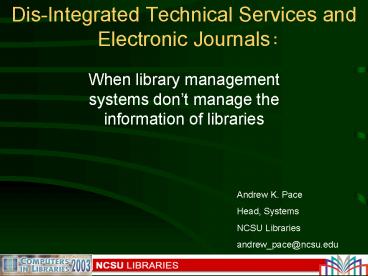DisIntegrated Technical Services and Electronic Journals - PowerPoint PPT Presentation
1 / 18
Title:
DisIntegrated Technical Services and Electronic Journals
Description:
e-journal finder. Serials Solutions. TDNet. web subject guides. Licensing ... Field Type: text, number, date, dollar. Estimated field size: number of characters ... – PowerPoint PPT presentation
Number of Views:25
Avg rating:3.0/5.0
Title: DisIntegrated Technical Services and Electronic Journals
1
Dis-Integrated Technical Services and Electronic
Journals
- When library management systems dont manage the
information of libraries
Andrew K. Pace Head, Systems NCSU
Libraries andrew_pace_at_ncsu.edu
2
Confessions of a Systems Librarian
- Whats in a name?
- Everyone is entitled to my opinion.
- The Systems Department raison dêtre.
- The bait-and-switch.
3
Classic Integrated System
MARC Records
Patron Records
Patron self-service
WEBPAC
circ transactions
- websites (856)
- e-books
- e-journals
- databases
- datasets
reserve records
item holdings
serial holdings
Acquisitions Records
Serials Control Records
4
Dis-integrated Library System
- Licensing Files
- ILL Files
- Collection Management Files
- Helpdesk Files
- Statistical Files
alpha list of databases
subject list of databases
web subject guides
Authentication Authorization
- websites (856)
- e-books
- e-journals
- databases
e-journal finder
institutional repository
Serials Solutions
TDNet
SFX
alert services
MyLibrary
5
Electronic Resource Management
Vendor Efforts
Library Efforts
- Innovative Interfaces ERM
- Endeavor ENCompass
- Sirsi SingleSearch
- Ex Libris MetaLib
- CARL Goldrush
- EBSCO EJS
- MuseGlobal
- Various Ejournal Finders
- DLF Electronic Resource Management Initiative
- California Digital Library
- Cornell University
- Emory University
- Griffith University
- Johns Hopkins
- Kansas State University
- MIT
- Penn State
- Tri-CollegeConsortium
- UCLA
- University of Georgia
- University of Minnesota
- University of Washington
- Yale University
http//www.library.cornell.edu/cts/elicensestudy/
Or Googleweb hub
6
NCSU Libraries E-matrix
- The ad hoc E-Matrix Committee will implement a
prototype electronic resources management system
to support acquisition and licensing, collection
management, and resource discovery for the
Libraries' electronic resources
7
NCSU Libraries E-matrix
- define the need
- survey best practices and related local and
national initiatives - define functional specifications for the system
- build a data model which maximizes opportunities
for present and future interoperability with
existing systems (e.g., ILS, MyLibrary, Serials
Solutions, PeopleSoft) and utilization of
existing or emerging standards (e.g., OpenURL,
EDI, XML) - implement a prototype.
8
E-MATRIX
ADMINISTRATIVE METADATA
licensing
I L S
Website Catalog E-resources Alert
Services Local DBs Collections Digital
Archives
Data Repos- itories
subscript-ion info
statistics
E-MATRIX
DATA HOOKS
PRESENTATION LAYER
technical support
remote access
Other Databases E-journal finder ETDs Instnl
Repository Etc.
evaluative data
Evaluative Tools
vendor data
9
E-matrix Challenges
- Public interface is secondary concern
- Leveraging existing ILS data
- Adherence to emerging standards
- Avoid solutions looking for problems
10
Public Interface
11
Public Interface
Local Marc Subfield r c Core resource n
Narrowly related resource b Broadly related
resource
12
Existing ILS Data
- Know your ILS RDBMS (or hope that it is
relational!) - Database schema
- ERD (Entity Relationship Diagram)
- Leverages a lot of historical data
- Holdings data
- Pricing data
- Order, claiming, and licensing information
- Minimizes re-syncing data
13
Emerging Standards
- XML Schema for E-resource Management
- Workflow, specifications, data elements, schema
- CONSER, LC, and the gang
- NISO/EDItEUR
- Serial subscription data exchange
- Liblicense
- Basic terms and contracts for licensing
electronic resources - COUNTER and E-Metrics
- Statistical counts
- OpenURL, HANDLE, PURL, Global registry
- Persistent identifiers
- Shibboleth Internet2/Mace authentication project
14
Solve Only Known Problems
- Can the library ILL this pdf article?
- How do we manage subscription agent changes?
- How does Acquisitions schedule renewals for 50
different schedules? - How do we represent an embargo period?
- How do I inform all the stake-holders in the
library any time there is a change? - etc.
15
Getting started
- Stakeholders Cataloging, Acquisitions, Serials,
and Collection Management - Identify data that are already being kept
- Identify data that are needed for evaluation,
longevity, and various services
16
Finding Data Elements
- Field Name
- Field Type text, number, date, dollar
- Estimated field size number of characters
- Required field y/n
- Multiple occurrences y/n
- In ILS y/n
- Already stored electronically? (i.e.
Access/Excell) - Field applies to book, database, journal, all
- Data entry by cataloging, acquisitions, collmgmt
- Example of data
- Notes
17
E-matrix / ERM Future
- Taking the E out of E-matrix
- Is the ILS superfluous?
- Is MARC dead?
- Will libraries or their vendors corner the ERM
market?
18
Thank you.
Andrew K. Pace Head, Systems North Carolina State
University Libraries andrew_pace_at_ncsu.edu http//w
ww.lib.ncsu.edu/staff/pace































